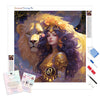Diamond Painting 101: How to Tame Static in Your Drills
You've probably been there: You dump all your shiny new drill bits into a tray, and instead of them sitting neatly in rows and columns, they're all scrambling around or sticking to the sides of the tray and flipping over. Or worse, your drills are sticking to each other, forming small, unmanageable clumps that attract every piece of dust in the room. This common but frustrating phenomenon is all thanks to a silent culprit: static electricity.
This guide will explain the causes of static electricity, quick solutions you can try when you encounter static electricity, and how to prevent static electricity, helping you to better complete your diamond painting.

Why Do My Drills Get Static
So, why are your drills so clingy? Simply put, static electricity is a buildup of electrical charge on the surface of an object. In the context of diamond painting, that charge is created by friction. As the plastic drills rub against each other, the plastic tray, or the plastic storage bags they come in, they exchange electrons. This creates an imbalance of charge, so some drills become positively charged, and some become negatively charged. Since they are extremely light, this electrical charge leads them to cling to anything that has the opposite charge-including the tray itself, tools you are using, and even your hands. Knowing the "why" is an important first step in knowing how to combat it.

How to Get Rid of Static
Once static hits, you need quick, easy solutions to get your project back on track. Here are our top-rated solutions for the most common issues.
A. For Drills Stuck in the Tray:
Static is most often associated with this scenario, where drills won't stay down in the grooves of the tray.
The Dryer Sheet trick: A classic for a reason (it works quickly)! Find a used dryer sheet somewhere and gently wipe the inside surface of your diamond drill tray. The fabric softener on the dryer sheet neutralizes the semi-static charge, and leaves the surface smooth and clear of static. If you want a more permanent solution, you could also cut a very small piece of the dryer sheet and tape it to the bottom of the diamond drill tray.
The Water Mist: Static electricity hates humidity. One quick fix here is to take a fine-misting spray bottle and apply a single, very light spritz of water just above the drills in the tray. The tiny bit of moisture (ideally in the air) will help dissipate the static electric charge, without wetting your drills.
The Tacky Putty Method: If you have some particularly cantankerous, static-filled drills that are flipping upside down and refusing to behave, don't try to use your pen on them. Instead, use a very tiny bit of tacky putty on the end of a wooden stick. Gently touch the top of the disobedient drill with the putty to lift it and place it on your canvas. This method gives you perfect control.
B. For Drills Sticking to Each Other:
When your drills have so much static they’re clinging to each other in clumps, a different approach is needed.
The "Shake and Rub" Trick: If your diamond drill bits are sticking together, often times a simple shake will do the trick. Place the static-charged drill bit in a small plastic bag or a small bottle from your storage box and gently shake it with your hands (and rub the bag) for a few seconds. This friction will help redistribute the charge, allowing the drill bit to detach and fall freely.

The Small Pouch Method: If you find yourself having a hard time with static, you can make a small anti-static pouch. Take a small piece of used dryer sheet (or very lightly dampened cotton ball) and place the dryer sheet or dampened cotton ball into a small coin purse or in a separate plastic bag with the drills. The constant, gentle contact will help to continuously neutralize any static charge that builds up.
How to Prevent Static
The best way to deal with static is to prevent it from happening in the first place. Some very easy changes to your work area and practices can be the difference in creating static-free diamond art projects.
Add Humidity to Your Workspace: Static loves dry air. If you live in a dry climate or are creating your masterpiece in a heated or air-conditioned room, the low humidity content is more than likely the main reason static is an issue. You should consider putting a small humidifier in your crafting space. This very simple move can help you combat the buildup of static on your tools and drills.
Keep Your Drills and Tools Clean: All kinds of dusty little pieces, like dust, lint, pet hair, etc. act as static magnets. All these little 'pull-globs' contribute to the static problem. Making a habit to routinely wipe out your trays and clean the containers you keep your drills in is the best tool to help you stop static cling from ruining the appearance of finished art.
Consider Your Materials: Some plastic trays are more prone to static than others. You might want to try using a tray that is made of a different material, like metal or silicone, if you find that you have static issues regularly. These other materials are less prone to static charge.

Say Goodbye to Static
Static is a common phenomenon when creating diamond art paintings, but with these simple tricks, you can tame the cling and get back to creating beautiful art. Remember to use a dryer sheet for stubborn trays, a quick spritz of water for a fast fix, or a proactive approach to prevent it altogether. These simple tips are all you need to keep your drills in line and your crafting smooth and enjoyable. Ready to start a frustration-free project? Choose the method that works best for you and give it a try on your next masterpiece!

























